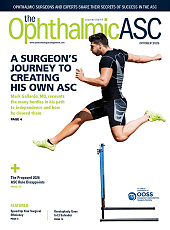The following transcript has been edited for clarity:
Hi, I’m Roger Goldberg, MD, with Retinal Physician and I’m thrilled to be here with my great friend and colleague, Diana Do, MD. Diana, you presented some phenomenal data on pegcetacoplan (Syfovre; Apellis Pharmaceuticals) treatment. Tell us about it.
Diana Do, MD: At the American Society of Retina Specialists meeting, I had the privilege of giving data on how the fellow eye grows in patients with bilateral geographic atrophy. Previous studies had shown that in people with bilateral GA, the lesions tend to grow at the same rate. We wanted to look at this in a post hoc analysis of the OAKS and DERBY studies. When we looked at the fellow eyes, they grew in similar rates as how the sham-treated eye would be. This is important data because it validates the use of the fellow eye as a control group in clinical trials. That’s something to consider when we’re looking at therapies in patients who have disease in both eyes.
Roger Goldberg, MD: There’s been some criticism in the GALE study [because] they used a projected sham in years 3 and 4, because the sham treated eyes rolled over into treatment. Does the fellow eye give us any information as to the validity of using that projected sham?
Diana Do, MD: That's a great question. When we looked at the growth rates and we plotted them out, the fellow eye grew at the same rate as the sham would. It shows us that if we extend those curves, it validates how they would behave over time. So it is a good internal validation, and it goes to the fact that pegcetacoplan’s effect in reducing geographic atrophy increases over time. So we should intervene earlier if we're going to employ a C3 inhibitor [and] save more retina quicker.
Roger Goldberg, MD: Awesome! Thank you so much for joining me. It's great to be here with Retinal Physician at ASRS 2025 in Long Beach, California. RP








